The Log Project
Image: Jumbled logs in a pile with some green leaves and other dry, wilted leaves.
Cedar Rapids 2020
A Derecho Changes Cedar Rapids Forever
A derecho is a straight-line wind storm that can cause hurricane-force winds, tornadoes, heavy rains and floods.
On August 10, 2020, a derecho passed through Iowa with no warning, downing trees and power lines, damaging homes, mowing down crops, and stripping towns and cities of their tree canopy. Here in Cedar Rapids, the winds reached 140 miles per hour, the equivalent of a Category 4 hurricane. We lost approximately 70% of our urban canopy, and though the city vows to replant the trees, our landscape is forever changed. Soon after the storm, Linn County was declared a federal disaster zone, and the National Guard provided relief. The Log Project is a longterm Intermedia piece comprised of video, photography, writing, and a codex + installation made from logs collected at sites throughout Cedar Rapids.
The Site of Two Disasters
Time Check Neighborhood
A neighborhood decimated by the floods in 2008 has become the dumping ground for felled trees from all over Cedar Rapids.
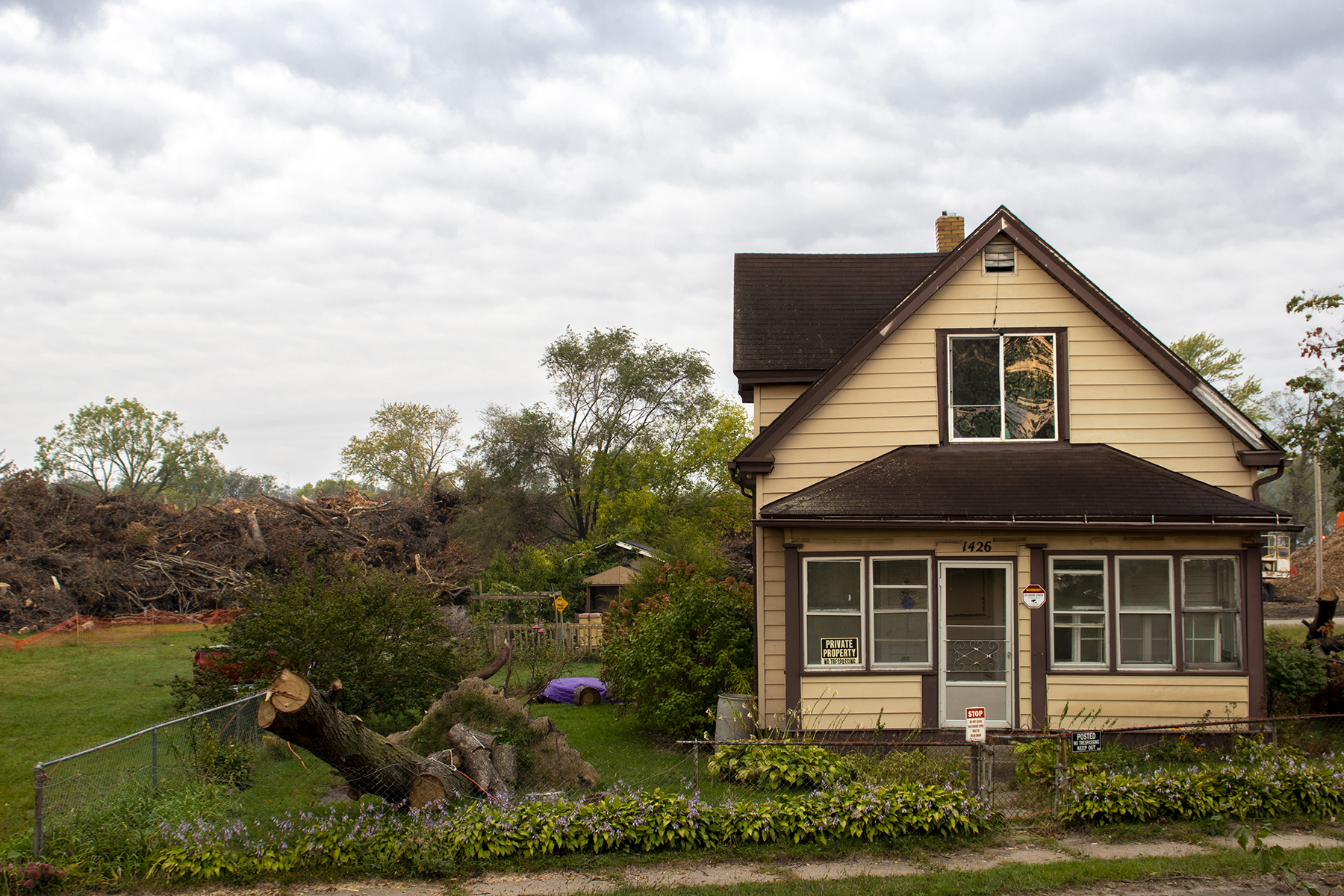
The Time Check neighborhood in NW Cedar Rapids got its name from the post-dated paychecks railroads used to write their employees, many of whom lived in this working-class district. Local banks honored these checks on a credit system, and the nickname stuck.
It was always a neighborhood on borrowed time–in more ways than one.
On June 13, 2008, when the Cedar River crested at a record-breaking 31.12 feet, many of the houses in Time Check were drowned up to their roofs. Only a few houses remain here now, after most were declared uninhabitable & demolished. The neighborhood will not be rebuilt.
The ’08 flood was the 6th largest FEMA designation in history, after Hurricane Katrina, 9/11, the Northridge earthquake, and Hurricane Ike.
And yet, it did not receive the media coverage it deserved, nor was it placed in the proper context of the Climate Emergency.
When derecho hit, the city filled Time Check with felled trees. Where once there were waves of floodwater, now there are waves of wood.
Two climate change disasters intersect here, a strong statement of the risks to Cedar Rapids — and more broadly, the planet — if we do not respond to the Climate Emergency.
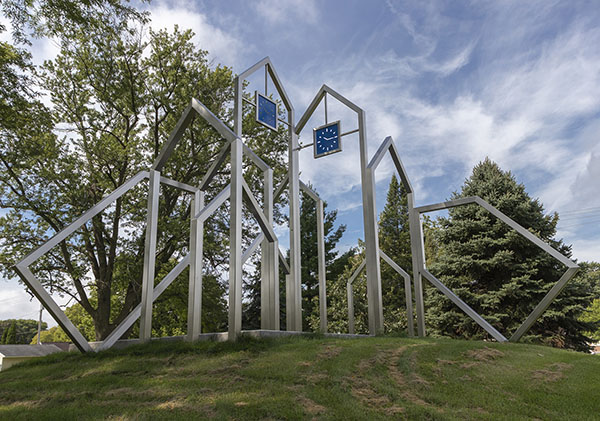
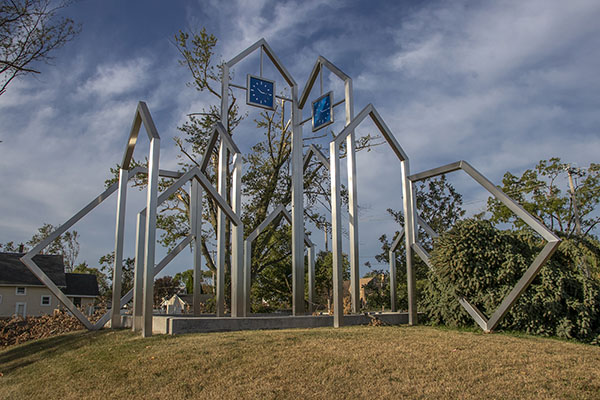
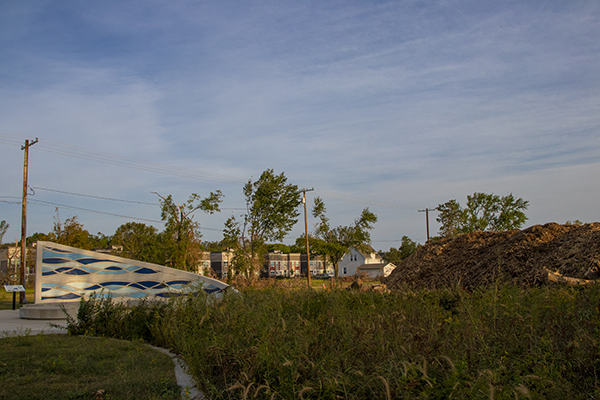
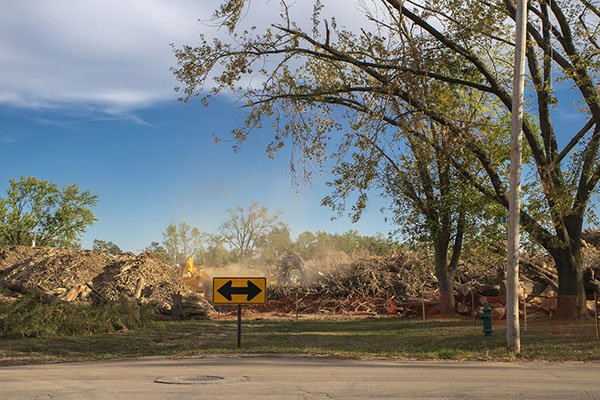
Wooden Codex: Story of the Storm
codex, an ancient manuscript text in book form
from Latin caudex for “trunk of a tree.”
A codex is an ancient manuscript book, usually comprised of vellum—not the kind found on the shelves of your local Dick Blick, but sheets of prepared animal skin — bound along one edge. Some codices were made from wood, like the Kellis Isocrates Codex found in Dakhleh Oasis. Visualize the plates of the Book of Mormon, except instead of metal, thin wood plates or boards, strung together on one side.
The ancient person who made the Kellis Isocrates Codex etched an inverted V on one side of a single log before cutting. So long as the inverted V aligned on the spine, the “pages” were in order and the uneven surfaces of facing plates would fit together.
Our codex will not be made from a single log, but rather, logs collected from sites all over Cedar Rapids in the wake of the Derecho on August 10, 2020. Slices of all different diameters and species will clang together awkwardly and stack precariously. The form is the story: a city uprooted, out of place. It also records the variety of trees felled by the Hurricane Derecho, as Iowans have come to call the storm.
In a way, it creates one tree trunk from many, embodying the original Latin meaning of codex.
We have been careful to tag every log with its provenance so that each wood slice tells its own part of the story. We will use a pyrography pen to draw and write stories, as well as homemade inks & paints — some made from storm debris.
We are emphasizing the tree’s stories, writing from a Green Criminology perspective. In Green Criminology, victims go beyond humans (and property) and crimes go beyond those codified by the criminal justice system. Flora and fauna can be victims, too, of environmental crimes. What if we defined the trees as not just something we lost, but as primary victims on par with us?
For example:
We collected logs from the curb outside Grant Wood’s studio. We have imagined this “page” in the codex as his famous painting Death on Ridge Road, typically viewed as an impending car wreck about to kill the people inside the vehicles. But to the side of the road, looming over the cars, stands a utility pole: a pole made of wood—wood that was once a tree. That tree is a victim, too: of our need for phone lines and electricity. The coal burned to produce electricity at the time polluted the air with mercury and lead, which is contained within tree rings — literally, air pollution made flesh. If sliced and examined, that utility pole may have contained in its rings (depending on when it was chopped down) the pollutants produced to generate the electricity that traveled through the wires it held up. The cars, too, are made from metals mined from the earth—a highly destructive and polluting extraction process. Pollutants from the fuel for those cars have led us here, to this moment, in the wake of derecho. It all comes full circle.
Another log we collected came from the Alzheimer’s hospice that cared for Karrie’s father. For this “page,” we will create a wax tablet with two contrasting layers of wax. The top layer will contain magnetite (iron oxide) aka Mars Black to darken it so that when one draws into the wax, the bottom layer contrasts, making it easier to read. Abnormal levels of magnetite/iron oxide have been found inside the amyloid cores in the brains of people with Alzheimer’s. The source: combustion-derived pollution. So here we are mimicking the memory loss of Alzheimer’s with temporary writing that can easily be scratched out of the wax, but also the pollution that caused derecho and victimized this tree. The rings of these logs will contain iron oxide as well, permanent records of our crimes. Here, the trees and the brains of Alzheimer’s patients share a forensic signature of the crimes against them.
We collected over 90 logs from various locations in every quadrant of Cedar Rapids, some from historically significant locations and some personally significant ones, such as Karrie’s childhood backyard—a tree they used to climb. Some are from personal “crime scenes”—logs from houses where siblings died, for example—and the intersection with environmental crimes comes full circle.
The slices on this display are early cuts from logs — sliced in the immediate wake of derecho. We sliced these knowing the wood had not yet dried and was still technically living tissue, with water inside that would eventually dry, leaving cracks as the tissues shrunk. We wanted to preserve a record of the trees as alive, and to show the cracks in the rings, in time, as physical testimony.
Most other slices are being done currently, after the logs have dried for one year. It is a longterm process, and this is also an essential element of the story, as Cedar Rapids is still recovering from this environmental crime, this trauma.
The Log Project incorporates other evidence as well, including video, photography, fiber arts, and inks made from storm & tree debris. The codex is a crime report as told by the trees.
Reimagining What was lost
The little Forest
The logs collected from around the city become the basis for the codex, but the remaining parts become an installation – pieces of a larger whole. Together they represent the quadrants of the city and a tiny proportion of what was lost – tree cover, oxygen generation – a vital component within the larger ecosystem of the city.
In an era of global deforestation and environmental crisis, the log forest becomes a call to action – save what we have, restore what we have lost, and regain our connection to the environment from which we came.
Image: A trunk of a tree is marked with a yellow tag and an orange dot. The yellow tag reads, “Danger, hazardous tree do not remove tag. Trim only.” On the textured bark blue and green algae is visible
the Artists
Karrie Higgins
is an Intermedia artist & disability activist living in Cedar Rapids, Iowa. Her art, writing, and photography have appeared in numerous publications, including Huffington Post, Western Humanities Review, Los Angeles Times, and The Cincinnati Review, for which she won the Schiff Award for prose. She has two notables in Best American Essays. Her video performance, “The Valley of the Dry Bones” was exhibited at the 2014 Intermedia Retrospective at the University of Iowa.
Alan Murdock
is a documentary filmmaker, photographer and creative director living and working in Cedar Rapids, Iowa. His work spans from documentary, corporate, wedding and educational video to website design, logo design, social media management as well as copywriting and direction for numerous small to medium sized businesses. Alan has 20 years of experience working in higher education as a faculty member and administrator of media, art, design and design research.
